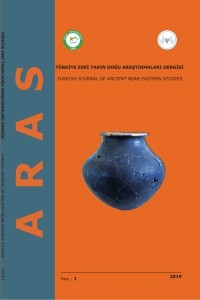
Aras Türkiye Eski Yakın Doğu Araştırmaları Dergisi
Yazarlar: Esra KAÇMAZ LEVENT
Konular:Arkeoloji
Anahtar Kelimeler:Urartu,Kemer,Adak Levhası,Bronz,Mitolojik Yaratık,Din.
Özet: This study presents an examination of five belt fragments and one votive plaque housed in the Mardin Museum collections. These bronze objects of unknown provenance were acquired by the museum by purchase, and conservation work on the objects was undertaken by museum staff prior to this study. Belt fragments belong to medium-width belts and the votive plaque has a square form. Materials that these objects were made from, and the decoration techniques employed for the depictions on them are in line with the characteristics of Urartian metal objects. Likewise, motifs and figures depicted on the belt fragments and the votive plaque parallel classical examples of Urartian art. Depictions include decorative motifs such as rosettes, the cable pattern, rhombuses, and double circles, and figures such as horsemen, lions, bulls, gods, and mythical creatures. Stylistic analysis of figures and compositions on these belt fragments from Mardin Museum in comparison to belts from museums, private collections, and archaeological excavations, help us identify these artifacts as products of 8th – 7th c. BC Urartian palatial style. The votive plaque examined here dates to the 8th – early 6th c. BC.